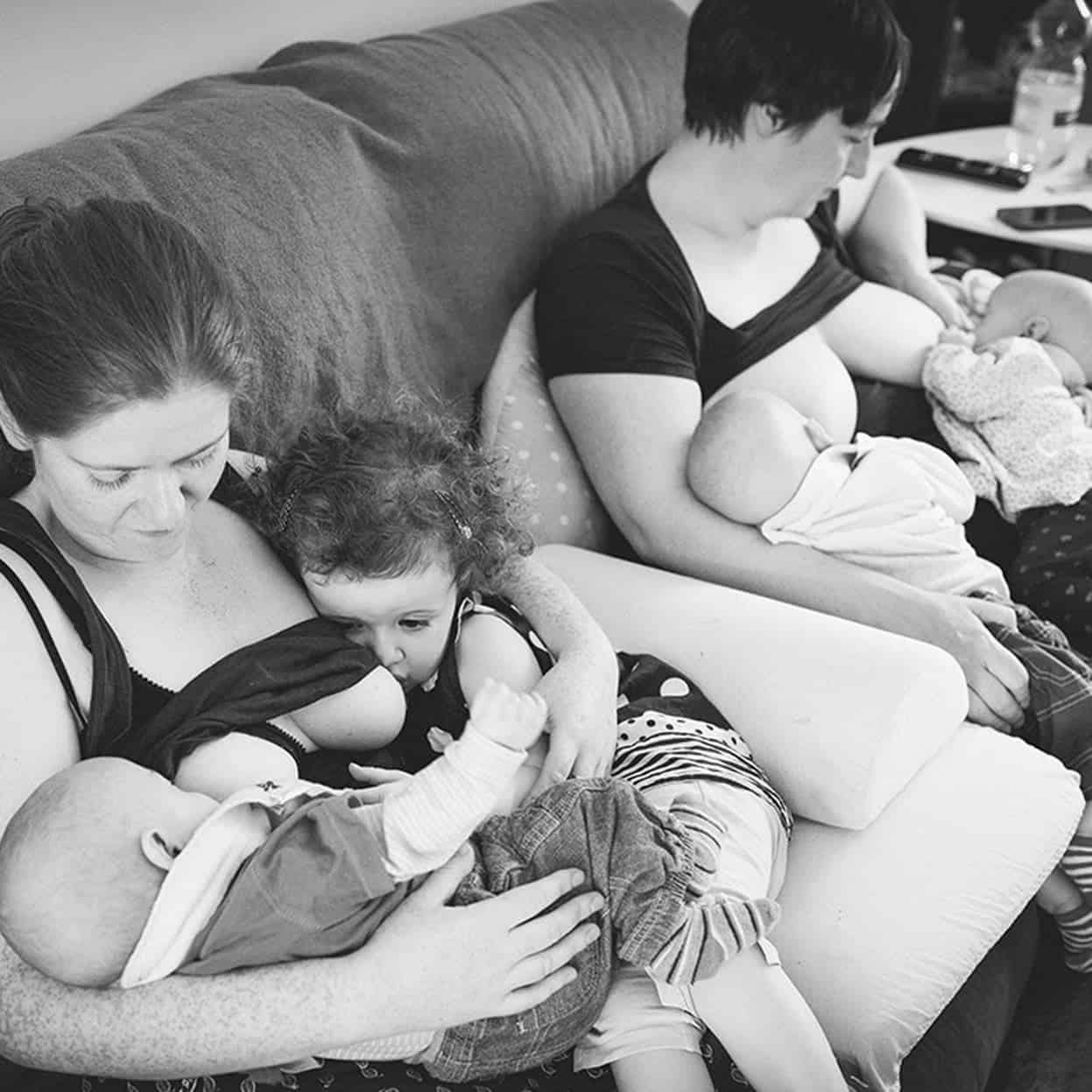Nursing a toddler and discovering that a new baby is on the way can be intensely questioning for some mothers.
If you’re still nursing your child and find out that you’re expecting another child, you might ask yourself: “What’s next as regards breastfeeding? “
For some mothers, they have to breastfeed during pregnancy or even after, and the decision to wean their baby is a simple one.
For others, things are not as simple as they seem, and they may begin to consider breastfeeding their baby.
Although there is no exact answer, mothers should opt for whatever works best for them and their families.
Plus, if you’re considering tandem breastfeeding – breastfeeding your new baby and the older child at the same time – you should know that it is an option that is generally safe, common, and healthy.
What Is Tandem Breastfeeding?
Tandem breastfeeding is the nursing of more than one child – two or more children of different ages simultaneously.
This usually occurs when you’re nursing an older baby, and then another baby – a newborn – comes into the picture.
It is rare to find more than two children breastfed, as most mothers tandem breastfeed just two children—an older child and a newborn. However, if you give birth to multiples or are nursing multiples, you may breastfeed more than two children.
Tandem breastfeeding generally means that you will be breastfeeding your older child throughout your pregnancy. Sometimes, older children cease to depend on their mothers for nourishment.
This is usually caused by a reduction in milk supply associated with pregnancy. Interest in nursing can always be revived upon the newborn’s arrival and when the milk supply is restored.
Tandem Breastfeeding vs. Breastfeeding Twins
Tandem breastfeeding is the same as breastfeeding twins in that you’re simultaneously meeting the needs of more than one nursing child, which can be quite balanced.
When tandem breastfeeding, you are likely to encounter the same difficulty, such as making a decision to breastfeed your children either separately or at the same time.
You may also find yourself making use of the same breastfeeding positions when you breastfeed both children at the same time.
Conversely, there are some differences between tandem breastfeeding and breastfeeding twins; in tandem breastfeeding, you’re nursing children of different ages.
The older nursing child doesn’t rely solely on breastfeeding because, unlike newborns, they also eat solids.
Therefore, your older child will likely not need to be breastfed frequently like your newborn.
How to Tandem Breastfeed?
Tandem breastfeeding has no fast or hard rules. Not all babies are the same, and every nursing toddler has diverse needs.
Mothers should ensure they find out what works best for them and their children and always remember that a method that works one week may not work the next.
What matters is adjusting to the needs of your children and ensuring that you observe your mommy’s boundaries, as breastfeeding more than one child at once can make you feel “touched out” and overwhelmed.
Things to Keep in Mind When Tandem Breastfeeding
The body produces enough milk to feed both children, but if more concern is placed on the newborn getting enough milk, you may consider feeding the newborn first before attending to the older child.
While some women decide to allocate sides to both of their children, switching sides from each feeding interval or combining methods is advisable.
Your milk supply will become sufficient, and you’ll tend to get into a pleasing breastfeeding routine with your baby; depending on your preference, you may want to consider feeding both children at once.
There’s no perfect answer to structuring your feeding routine, but it’s better to believe enough milk would be generated by the body to feed both children, and there won’t be any need to try and control the experience.
What Breastfeeding Position Works Well for Tandem Breastfeeding?

Finding a comfortable position for everyone involved when practicing tandem breastfeeding may not come easily and can involve some trial and error at first.
Most mothers practicing tandem breastfeeding tend to prefer breastfeeding positions for twins.
Let’s see some positions where we can latch two babies to the breast.
- Where there’s a bed with enough space for everyone to get comfortable, you can try the laid-back position with both the newborn and toddler reclined on you while you breastfeed.
- You can try breastfeeding one child in a football hold and the other in a cradle.
- You can have the toddler kneel next to you to breastfeed while holding the newborn in a cradle.
Common Concerns While Carrying Out Tandem Breastfeeding
Is It Safe to Breastfeed During Pregnancy?
Many nursing mothers tend to develop concerns as to whether the fetus in their womb would be getting enough nutrition or if they are subjected to the risk of a miscarriage.
These concerns are well understood, although a 2012 study noted that breastfeeding during pregnancy poses little or no risk to both the mother and the growing baby.
The American Academy of Family Physicians (AAFP) describes breastfeeding during a subsequent pregnancy as not unusual. If the pregnancy is normal and the woman is healthy, breastfeeding during pregnancy is a personal decision to be made by the woman.”
The AAFP stresses the point that breastfeeding into the toddler years Is a necessity for children, which is enough reason to try when you get pregnant and want to continue breastfeeding.
Breastfeeding during pregnancy does come with its challenges, some of which may include emotional and hormonal shifts, sore nipples, and the possibility of your child weaning due to a reduction in milk supply resulting from pregnancy hormones.
Again, doing what works for you is the best option, as breastfeeding during pregnancy is a personal decision.
Will There Be an Increase in the Supply of Milk Enough for Both Children?
Another major concern that crosses the mind of mothers practicing tandem breastfeeding is whether they will be able to generate sufficient milk for both of their children.
Surely, the body will produce enough milk that will be sufficient for both children, and the milk produced will possess a very potent nutritional value for both children.
When a woman becomes pregnant, the body begins preparation to breastfeed. Even while still breastfeeding the older child, the body produces Colostrum for the newborn and then creates a milk supply suitable for both the needs of the toddler and the infant.
The milk supply uses a demand and supply principle; thus, more milk demand by the children will result in more milk supply by the body.
Benefits of Tandem Breastfeeding
There are numerous benefits to tandem breastfeeding, some of which may include;
- It may help reduce insecurity in older children, making them feel secure and reassured while transitioning into a new family setting.
- The older child can aid a speedy milk supply boost if needed.
- Breastfeeding the older child alongside the newborn is a safe way of keeping both of them in check and away from trouble or harm.
- If you tend to get very engorged, the older child can help reduce symptoms of engorgement when the milk comes in.
The Challenges of Tandem Breastfeeding

Besides the basic worries of milk supply, one of the major challenges that mothers feel while breastfeeding at times is the stress that comes along with it, as it can be quite overwhelming.
You may feel like you don’t have time for yourself anymore as you’re constantly breastfeeding. You may feel agitated or touched out, considering the children are always hands-on around you.
Setting up basic rules for the older child is very much advisable when you begin to feel like the stress coming with tandem breastfeeding is just too much. Some things to consider in this situation include;
- Reducing the number of times they feed per day.
- Limiting their duration on the breast, you can set a timer or sing a poem several times and then unlatch them from the breast.
- Teach them to cut back naturally using the “don’t offer, don’t refuse” technique.
In circumstances where nothing helps, weaning can be a viable option. Just ensure that you do it gently so that the child can adjust and the breast doesn’t get overfull. Weaning shouldn’t bring about the end of bonding; you and your child should find new ways to bond.
Conclusion
Despite being an excellent option for mothers and children, tandem breastfeeding can, however, feel isolating. It does help to know that you’re not alone.
Before embarking on the tandem breastfeeding procedure, you should try reaching out to a breastfeeding counselor or lactation consultant. Joining a breastfeeding support group can also be very helpful.
Tandem breastfeeding can be quite spectacular, but it does come with its challenges, so finding support would play a vital role in the procedure’s success.








